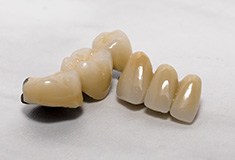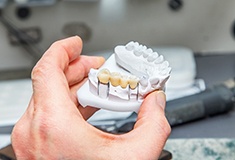
Like millions of other Americans right now, you’re dealing with an ongoing dental problem. You have a cavity, a severely chipped/cracked tooth, or even a few missing ones. What do you do? For the people of Forest, VA, the solution is as easy as picking up the phone and calling Crossroads Family Dentistry. There, our team can use a specially-designed crown or bridge to make your problem seemingly disappear, often over the course of just two simple appointments.
What is a dental crown?
You can think of a dental crown as a fancy hat for your tooth. In reality, it is a tooth-shaped restoration that simply fits over the top of a damaged tooth. With one, we can:
- Repair a large cavity
- Restore a broken tooth
- Hold a weakened tooth together
- Help align the bite to address TMD issues
- Complete a dental implant
- Cosmetically improve a misshapen or undersized tooth
Crowns can be made of a variety of materials, ranging from strong and durable metal for the back teeth to beautiful (and still durable!) porcelain for the front teeth. Modern materials have given us the ability to create beautiful, strong crowns for any spot in the mouth. In most cases, the process to design and place one only takes two visits spaced about a week apart.
What is a dental bridge?

Instead of treating a tooth that is already there, a bridge is used to help bring missing teeth back. For this, two crowns are placed on the teeth on either side of the gap in a patient’s smile, and these are attached to prosthetic teeth (or tooth) to close it. Bridges can be made to be fixed or removable, and they can even be supported by dental implants to deliver a better result.
In any case, our team only works with the finest local dental labs to fabricate your restorations ensuring they are beautiful, natural-looking, and built to last. If you’re tired of dealing with problem (or missing) teeth, give us a call today, and you’ll have your original smile back before you know it!
Dental Crown FAQs

A dental crown has been used for generations to repair damaged teeth while also providing an added layer of protection. Despite their success rate, dental crowns in Forest as a big commitment. Your dentist will explain the entire process during your consultation; however, here are the answers to a few frequently asked questions to ease any apprehensions.
Are dental crowns permanent?
Dental crowns aren’t permanent because they need to be replaced, eventually. Since your tooth must be altered to bond a crown over it, the procedure isn’t reversible. Your tooth will always need to be covered because your enamel won’t grow back. Thankfully, you won’t have to budget for a replacement often. A crown can last for about 5 to 15 years, but it’s not unusual for one to last for decades with the right maintenance. You can prolong the lifespan of your restoration by brushing and flossing. Don’t forget to visit your dentist at least twice a year for a cleaning and checkup. Your dentist in Forest will advise you to safeguard your crown from preventable damage, like using a mouthguard if you grind and clench your teeth. It is best to avoid chewing hard or sticky foods to prevent breaking or dislodging your crown. Don’t forget to wear an athletic mouthguard if you play contact sports. Your dentist will also recommend you don’t use your teeth as tools to open packages or chew on any inedible objects.
Can dental crowns get cavities?
No, a crown cannot get a cavity; however, your underlying tooth is still vulnerable to decay. Although you might believe it has less of a risk with the restoration covering it, your tooth will be just as susceptible to cavities as your other teeth. Bacteria and plaque can accumulate where the crown meets the gum line, gaining access to your tooth. Over time, small fractures can occur in the dental cement holding your restoration in place. Without proper oral hygiene habits, bacteria can enter through the small crevasses. You can protect your smile from decay by brushing, flossing, and visiting your dentist every 6 months for a cleaning and checkup. You’ll also want to limit your consumption of sugary foods and drinks.
Are dental crowns covered by insurance?
Every insurance policy differs, but most plans can be used to offset the cost of crowns. It’s unlikely your dental benefits will cover the entire amount, but they can pay up to 50% of the cost if it is medically necessary, such as to treat a broken tooth. After reaching your yearly deductible, you can use your annual allowance to lower your out-of-pocket expense. A member of our team will work on your behalf with your dental insurance to maximize your benefits. If there is any remaining balance, we offer several financing options to find the solutions you need to fit your budget, like third-party financing. We also have an in-house membership plan, which gives you access to discounted rates for common services, including restorative procedures.
Dental Bridge FAQs

Do you have gaps in your smile? Dental bridges are a great option for replacing missing teeth, but you may still have some unanswered questions about the restoration, so we’re here to help. Here are the answers to some of the most common questions we’re asked about dental bridges in Forest. If you don’t see the information that you’re looking for below, give us a call. We’d be happy to talk to you more about the process and get you started with an initial consultation.
Can You Take a Dental Bridge Out?
No, dental bridges are designed to remain in your mouth for many years after being placed. You shouldn’t be able to take a dental bridge out of your own – only a dental professional can. Some healthcare providers call partial dentures “removable bridges,” but this isn’t entirely accurate. Partials are similar to bridges, but one of the key differences is that partials can be removed by the patient at any time, but dental bridges cannot.
Is Getting a Dental Bridge Painful?
Before your teeth are prepared to support the bridge, your mouth will be numbed by a local anesthetic, so you shouldn’t feel a thing. After the preparation and placement of your dental bridge, the underlying teeth will likely feel sensitive for a few days. This can be managed with over-the-counter pain relievers. If discomfort persists or worsens, give us a call. Because dental bridges keep your remaining teeth from shifting out of place, they are able to prevent discomfort later on.
How Many Teeth Can a Dental Bridge Replace?
Depending on the needs of the patient, a dental bridge can replace anywhere from one to four missing teeth in a row. In most cases, bridges are used to replace just one or two teeth. The longer the bridge extends, the less stable it becomes, especially if the natural teeth supporting the bridge aren’t strong and healthy. Ultimately, it becomes riskier to replace three or more teeth with a dental bridge. Implant bridges can lower this risk, as implants are just as strong and secure as natural teeth.
Do Dental Bridges Feel Natural?
Within just a few days of receiving your permanent dental bridge, it should start to feel increasingly natural. Bridges are made from durable materials that can stand up to everyday chewing forces just as easily as tooth enamel, so eating with a bridge shouldn’t feel strange. Each bridge is customized based on impressions taken of the tooth, so it shouldn’t feel awkward or even noticeable.